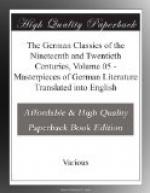It has often been attempted to make clear the position of the artist in regard to Nature, by saying that Art, in order to be such, must first withdraw itself from Nature, and return to it only in the final perfection. The true sense of this saying, it seems to us, can be no other than this—that in all things in Nature, the living idea shows itself only blindly active; were it so also in the artist, he would be in nothing distinct from Nature. But, should he attempt consciously to subordinate himself altogether to the Actual, and render with servile fidelity the already existing, he would produce larvae, but no works of Art. He must therefore withdraw himself from the product, from the creature, but only in order to raise himself to the creative energy, spiritually seizing the same. Thus he ascends into the realm of pure ideas; he forsakes the creature, to regain it with thousandfold interest, and in this sense certainly to return to Nature. This spirit of Nature working at the core of things, and speaking through form and shape as by symbols only, the artist must certainly follow with emulation; and only so far as he seizes this with genial imitation has he himself produced anything genuine. For works produced by aggregation, even of forms beautiful in themselves, would still be destitute of all beauty, since that, through which the work on the whole is truly beautiful, cannot be mere form. It is above form—it is Essence, the Universal, the look and expression of the indwelling spirit of Nature.
Now it can scarcely be doubtful what is to be thought of the so-called idealizing of Nature in Art, so universally demanded. This demand seems to arise from a way of thinking, according to which not Truth, Beauty, Goodness, but the contrary of all these, is the Actual. Were the Actual indeed opposed to Truth and Beauty, it would be necessary for the artist, not to elevate or idealize it, but to get rid of and destroy it, in order to create something true and beautiful. But how should it be possible for anything to be actual except the True; and what is Beauty, if not full, complete Being?
What higher aim, therefore, could Art have, than to represent that which in Nature actually is? Or how should it undertake to excel so-called actual Nature, since it must always fall short of it?
For does Art impart to its works actual, sensuous life? This statue breathes not, is stirred by no pulsation, warmed by no blood.
But both the pretended excelling and the apparent falling short show themselves as the consequences of one and the same principle, as soon as we place the aim of Art in the exhibiting of that which truly is.
Only on the surface have its works the appearance of life; in Nature, life seems to reach deeper, and to be wedded entirely with matter. But does not the continual mutation of matter and the universal lot of final dissolution teach us the unessential character of this union, and that it is no intimate fusion? Art, accordingly, in the merely superficial animation of its works, but represents Nothingness as non-existing.




